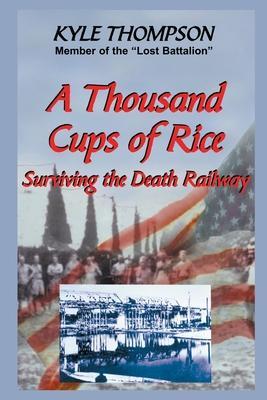A Thousand Cups of Rice: Surviving the Death Railway

A Thousand Cups of Rice: Surviving the Death Railway
You are only a few remaining skeletons after the invasion of East Asia for the past few centuries, and are pitiful victims. We will build the railroad if we have to {build} it over the white man's body. If you want anything, you will have to come through me. . . . and there will be many of you who will not see your homes again. Work cheerfully at my command.-Lt. Col. Y. Nagatomo, Chief, No. 3 Branch, Thailand POW Administration, Nippon Expeditionary Force
With these words, thousands of Allied prisoners were sentenced to their deaths on the "Burma-Siam Death Railway." Among the victims were Texans of the 2nd Battalion 131st Field Artillery, and survivors of the sunken USS Houston.
In 1939, while the Great Depression still loomed over the country, Kyle Thompson enlisted in the Texas National Guard at Wichita Falls, Texas. Thompson was only sixteen years old, and his mother had signed papers listing his age as eighteen so that he could join the military and draw the few dollars paid monthly to guardsmen.
After Nazi Germany overran most of Europe, President Franklin D. Roosevelt convinced Congress in 1940 to mobilize U.S. forces. Along with thirty thousand other members of the 36th Division, Thompson's unit was inducted into the regular army and sent to Camp Bowie in Brownwood, Texas, for intensive training.
Thompson was a member of the 2nd Battalion, 131st field artillery. The 2nd Battalion was deployed to the Netherland East Indies on January 11, 1942, the same day Japanese forces began their invasion of the island. After three months of intense fighting, the 2nd Battalion surrendered to the Japanese. It became known as the "Lost Battalion" due to its location being unknown throughout the remainder of World War II.
Moved to various prisoner of war camps throughout Southeast Asia, the "Lost Battalion" endured severe brutality, starvation, and disease. In 1943 they were moved to Burma, where they worked on what became known as the Japanese "Railroad of Death," which led to the death of 70,000 Allied prisoners and was the basis for the movie, The Bridge Over the River Kwai. In A Thousand Cups of Rice, Thompson recounts how he and the other prisoners survived their inhumane treatment and years of hard labor with little food and scarce medical treatment. All told, Thompson spent six years in the U.S. Army, four of them overseas in the southeast Asian theater of war.
PRP: 154.61 Lei
Acesta este Pretul Recomandat de Producator. Pretul de vanzare al produsului este afisat mai jos.
139.15Lei
139.15Lei
154.61 LeiLivrare in 2-4 saptamani
Descrierea produsului
You are only a few remaining skeletons after the invasion of East Asia for the past few centuries, and are pitiful victims. We will build the railroad if we have to {build} it over the white man's body. If you want anything, you will have to come through me. . . . and there will be many of you who will not see your homes again. Work cheerfully at my command.-Lt. Col. Y. Nagatomo, Chief, No. 3 Branch, Thailand POW Administration, Nippon Expeditionary Force
With these words, thousands of Allied prisoners were sentenced to their deaths on the "Burma-Siam Death Railway." Among the victims were Texans of the 2nd Battalion 131st Field Artillery, and survivors of the sunken USS Houston.
In 1939, while the Great Depression still loomed over the country, Kyle Thompson enlisted in the Texas National Guard at Wichita Falls, Texas. Thompson was only sixteen years old, and his mother had signed papers listing his age as eighteen so that he could join the military and draw the few dollars paid monthly to guardsmen.
After Nazi Germany overran most of Europe, President Franklin D. Roosevelt convinced Congress in 1940 to mobilize U.S. forces. Along with thirty thousand other members of the 36th Division, Thompson's unit was inducted into the regular army and sent to Camp Bowie in Brownwood, Texas, for intensive training.
Thompson was a member of the 2nd Battalion, 131st field artillery. The 2nd Battalion was deployed to the Netherland East Indies on January 11, 1942, the same day Japanese forces began their invasion of the island. After three months of intense fighting, the 2nd Battalion surrendered to the Japanese. It became known as the "Lost Battalion" due to its location being unknown throughout the remainder of World War II.
Moved to various prisoner of war camps throughout Southeast Asia, the "Lost Battalion" endured severe brutality, starvation, and disease. In 1943 they were moved to Burma, where they worked on what became known as the Japanese "Railroad of Death," which led to the death of 70,000 Allied prisoners and was the basis for the movie, The Bridge Over the River Kwai. In A Thousand Cups of Rice, Thompson recounts how he and the other prisoners survived their inhumane treatment and years of hard labor with little food and scarce medical treatment. All told, Thompson spent six years in the U.S. Army, four of them overseas in the southeast Asian theater of war.
Detaliile produsului









